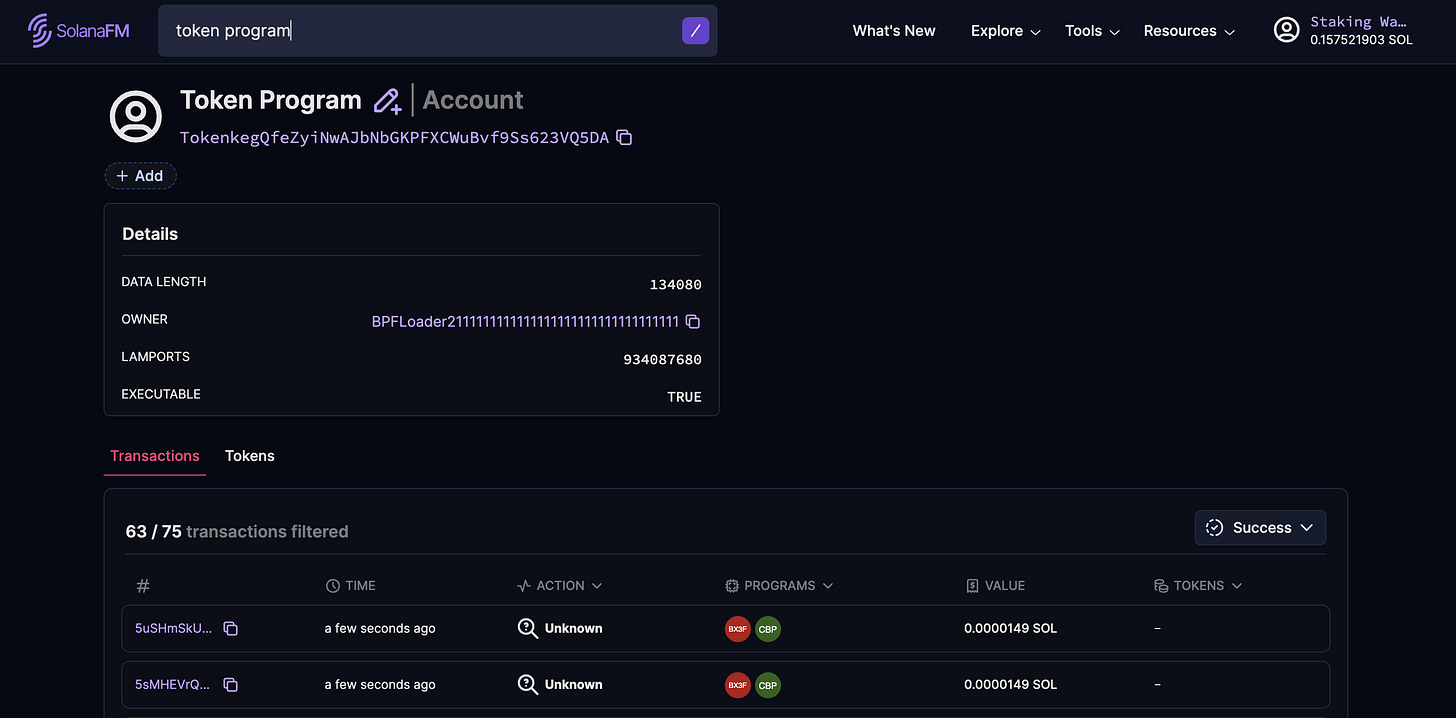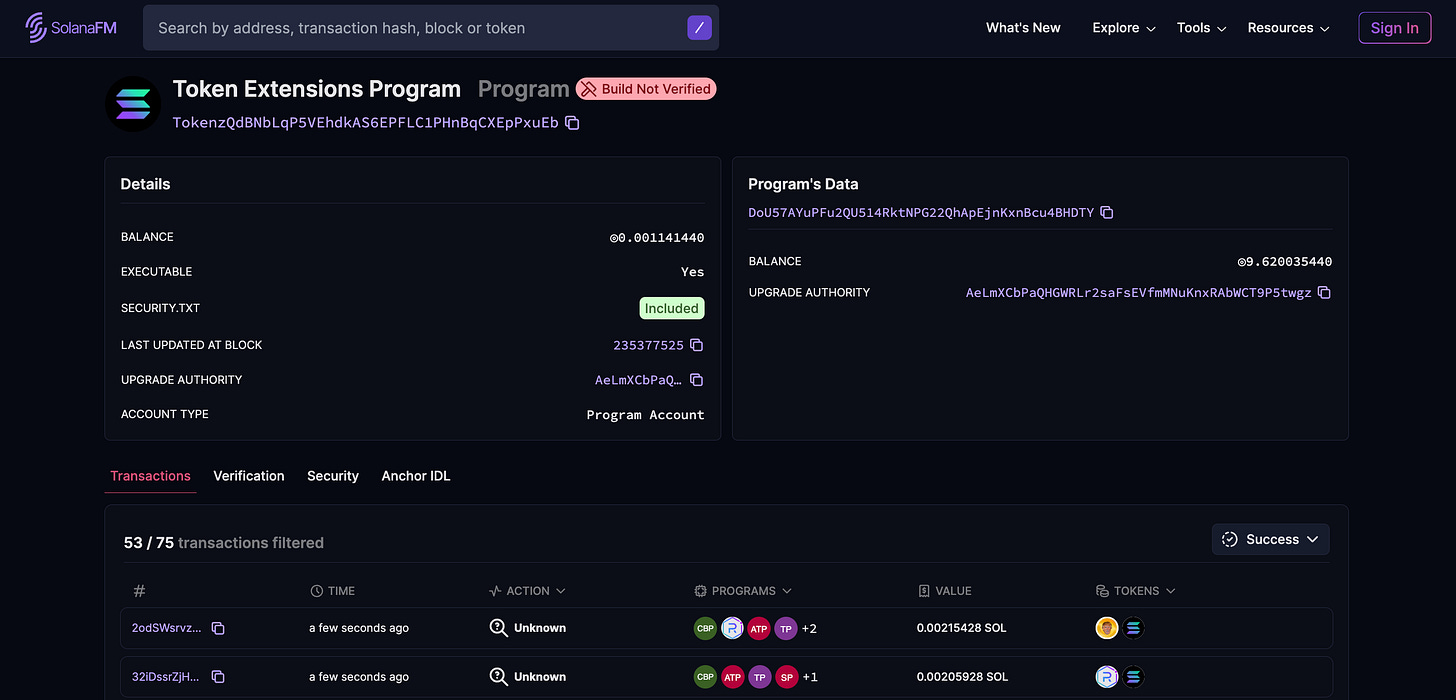Exploring Innovations on Solana: Token Extensions, cNFTs & Metaplex Core
This article will explore Solana innovations, explaining their significance for the ecosystem, and how to view them on-chain.
Contents
Introduction
Token Extensions
Compressed NFTs (cNFTs)
Metaplex Core
Outlook
Introduction
Solana is a pioneer of innovations in the Web3 space and is cultivating an ecosystem with a strong focus on developers, community-building and low barriers to entry.
In this article, we'll explore Token Extensions, compressed NFTs (cNFTs), and the Metaplex Core Standard which form part of a recent suite of innovations introduced to the Solana network.
1) Token Extensions
To understand Token Extensions, we will briefly explain common protocols guiding the creation of tokens in blockchain ecosystems.
Background
To deploy tokens, developers typically rely on common token standards that are unified across the blockchain.
For example, Ethereum relies on the ERC-Standard (Ethereum Request for Comment) to define rules for creating, transferring, and managing custom tokens. ERC standards each serve different purposes and functionalities e.g. ERC-20, most commonly used for fungible tokens and ERC-721, commonly used for NFTs.
On Solana, the Token Program sets the model for fungible and non-fungible tokens. Details regarding the implementation can be found on the Solana Program Library (SPL).
Token Extensions on Solana
While the Token Program followed a common standard, it had functional limitations that posed users, exchanges and wallets with various challenges to customise their token deployments. Token Extensions aim to address these limitations by having additional functionalities built on top of the Token Program.
The Token Extensions Program can be viewed on SolanaFM along with its past transactions and its Anchor IDL.
You can visit the program on SolanaFM here: Token Extensions Program
The two main categories of Extensions include Mint Extensions and Account Extensions which will be briefly explained in this part.
Mint Extensions
Mint Extensions add functionalities to the original token standard when minting i.e. when tokens are first deployed onto the blockchain. They include:
Confidential Transfers: Enables transactions without disclosing the amount transferred.
Transfer Fees: Custom-routing of fees for transfers, such as royalties, platform fees, and creator commissions.
Closing Mint: Allows management of mint accounts and close them to stop the creation of new tokens.
Interest Bearing Tokens: Permits the creation of assets that incorporate real-world functions like interest rates.
Non-transferable Tokens: Enables the creation of tokens that are permanently tied to an account.
Permanent Delegates: Delegates parties with full power to burn, freeze or remove tokens.
Transfer Hooks: Programmable transfers that enable the Token Program to call a chosen program for transfers, allowing customisation of transfer actions.
Metadata Pointers: Token creators can point to an external base where your metadata is stored.
Account Extensions
Account Extensions are additional account-related features which are appended to token accounts.
Memo: Makes all incoming transfers have a memo or note that is added on-chain.
Immutable Ownership: Ownership of the token account cannot be changed.
Default Token Account State: Newly created token accounts are initially frozen, requiring users to take specific actions to change their state.
CPI Guard: Certain activities are restricted during Cross Program Invocation (CPI) limiting how selected programs can interact with tokens.
View Token Extensions
To make it easier for developers to identify whether tokens are using Token Extensions, it is important for block explorers like SolanaFM to display their visibility.
SolanaFM offers full-range support for Token Extensions. Users can paste the token hash in the search bar to pull up the token page. Then users can see whether the token extensions display ‘true’.
You can search any token to see whether they are using Extensions. Below are a few tokens on Solana that utilise Token Extensions:
2) NFT Compression
Another innovation pioneered by Solana is NFT compression i.e. compressed NFTs (cNFTs). To address storage costs of NFT creators, the concept of cNFTs was developed by Solana Labs & the Metaplex Foundation.
Background
Minting and storing data on-chain for conventional NFTs is very costly.
For instance, conventional NFT projects can involve thousands of unique items and data sets stored on-chain, leading to significant costs.
Rough estimates conducted by Metaplex state that for a collection size of 1M NFTs, costs for storing and managing the data alone could amount to around 12k SOL.
Merkle Trees & cNFTs
With cNFTs, the NFT data is not stored within an on-chain account. Rather, the data is compressed via a Merkle Tree. A Merkle Tree compresses the data in a way that reduces the storage space which conventional NFTs would occupy on-chain i.e. via an account.
Instead of storing the actual data, only the hash (also called Merkle Root) of the data piece is stored on the Solana ledger. This single hash is then sealed cryptographically, ensuring the integrity of the data in the tree.
To visualise this, imagine a digital art piece that originally occupies 10 storage units being compressed to fit into just one unit.
View cNFTs on SolanaFM
Since cNFT data is not stored directly on-chain, it was challenging to view cNFTs on Block Explorers. SolanaFM provides full support for cNFTs on Solana. Users can view a range of cNFT projects on Solana, among them Tensorians or collectibles from the digital artist platform Drip.
NFT compression is a key innovation in the Solana space, offering the same functionalities as NFTs while improving storage efficiency and scalability. They make minting more affordable and NFT collections more accessible to a broader audience.
Metaplex Core
Another innovation rolled out was the Metaplex Core Standard. With Metaplex Core, a new Solana NFT standard was created, that made minting and managing NFTs even easier for creators.
What Metaplex Core improves?
Metaplex Core is specifically designed for NFTs, enabling all essential data to be stored in a single Solana account. This significantly simplifies the development process for creators.
Moreover, it provides creators with a flexible plugin system that allows for developers to modify the behaviour and functionality of assets.
Here is the Metaplex Core Program labelled on SolanaFM.
List of Improvements
Cost Efficiency: Metaplex Core provides lower minting costs than other alternatives. Core operations performed have a small compute unit footprint, allowing more transactions to be included in one block.
Single Account Design: Core utilises a single account design that tracks the owner and reduces complexity for developers.
Improved Collection Support: Assets can be grouped into Collections allowing users to execute collection-level operations.
Advanced Plugin Support: The plugin architecture of Metaplex Core enables customisation and utility enhancements for developers to add custom features.
Metaplex Core on Block Explorers
Marketplaces like Tensor will support trading of Core NFTs providing creators and collectors the platform support needed for new collections.
Solana NFT collections like Claynosaurz have also partnered with Metaplex to launch projects on NFT core.
Independent NFT artists like Ed McKenway or Emer already started utilising Metaplex Core for their art pieces. You can view NFTs making use of the Metaplex Core on SolanaFM:
Outlook
Solana is at the forefront of Web3 innovations, constantly adapting to meet the evolving needs of users and developers.
Token Extensions offer developers flexibility in tailoring tokens to their specific needs, while cNFTs reduce storage costs without sacrificing functionality.
In doing so, they continue to drive advancements in Web3, providing users and developers with the tools they need to navigate the ecosystem.
Appendix
Primer on Token Extensions by Yash Agarwal: https://yashhsm.medium.com/primer-on-solanas-token-extensions-ef8fbd717c56
What is Compression on Solana by Helius: https://docs.helius.dev/compression-and-das-api/what-is-compression-on-solana
What are compressed NFTs by Alchemy: https://www.alchemy.com/overviews/compressed-nfts
Solana’s Token Program Explained by Matt Lim: https://pencilflip.medium.com/solanas-token-program-explained-de0ddce29714
Core - The next generation of Solana NFT Standard by Metaplex: https://developers.metaplex.com/core














